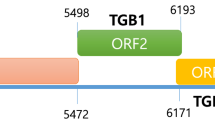Abstract
The genetic diversity of plum pox virus strain M (PPV-M) was assessed by analyzing 28 isolates collected in 8 European countries. Two genomic fragments spanning the (Cter)P3-6K1-(Nter)CI coding region as well as the full coat protein coding region were sequenced directly from PCR products. Phylogenetic analysis showed that the geographical origin of the collected isolates was clearly associated with two different PPV-M clades. Moreover, the pattern of substitutions in the CP gene shed light on the evolutionary relationships between PPV-M and the recombinant strains PPV-Rec and PPV-T.

Similar content being viewed by others
References
Candresse T, Cambra M (2006) Causal agent of Sharka disease: historical perspective and current status of Plum pox virus strains. EPPO Bull 36:239–326
Dallot S, Glasa M, Kamenova I, Paunović S, Pittnerova S, Kominek P, Jevremović D, Virscek-Marn M, Mavric Plesko I, Milusheva S (2008) Prevalence and genetic structure of PPV-M in six European countries. Acta Hort 781:227–234
Garcia JA, Cambra M (2007) Plum pox virus and sharka disease. Plant Viruses 1:69–79
Glasa M, Candresse T (2005) Partial sequence analysis of an atypical Turkish isolate provides further information on the evolutionary history of Plum pox virus (PPV). Virus Res 108:199–206
Glasa M, Palkovics L, Komínek P, Labonne G, Pittnerová S, Kúdela O, Candresse T, Subr Z (2004) Geographically and temporally distant natural recombinant isolates of Plum pox virus (PPV) are genetically very similar and form a unique PPV subgroup J. Gen Virol 85:2671–2681
Hall TA (1999) BioEdit: a user-friendly biological sequence alignment editor and analysis program for Windows 95/98/NT. Nucl Acids Symp Ser 41:95–98
Myrta A, Boscia D, Potere O, Kolber M, Nemeth M, Terlizzi B, Cambra M, Savino V (2001) Existence of two serological subclusters of Plum pox virus, strain M. Eur J Plant Pathol 107:845–848
Serçe ÇU, Candresse T, Svanella-Dumas L, Krizbai L, Gazel M, Çaglayan K (2009) Further characterization of a new recombinant group of Plum pox virus isolates, PPV-T, found in orchards in the Ankara province of Turkey. Virus Res 142:121–126
Tamura K, Dudley J, Nei M, Kumar S (2007) MEGA4: molecular evolutionary genetics analysis (MEGA) software version 4.0. Mol Biol and Evol 24:1596–1599
Acknowledgments
This study was partially supported by ECONET grant no.10159PL from the French Foreign Office and by projects APVV-51-0402-07 from the Slovak Research and Development Agency and TR-20013A from the Serbian Ministry of Science and Technological Development. Many thanks to Dr. A. Myrta, Dr. D. Boscia and Dr. P. Kominek for providing us some of the PPV isolates sequenced in this study and to Dr. G. Thébaud and Dr. T. Candresse for fruitful discussions.
Author information
Authors and Affiliations
Corresponding author
Electronic supplementary material
Below is the link to the electronic supplementary material.
Rights and permissions
About this article
Cite this article
Dallot, S., Glasa, M., Jevremovic, D. et al. Mediterranean and central-eastern European countries host viruses of two different clades of plum pox virus strain M. Arch Virol 156, 539–542 (2011). https://doi.org/10.1007/s00705-011-0918-y
Received:
Accepted:
Published:
Issue Date:
DOI: https://doi.org/10.1007/s00705-011-0918-y




